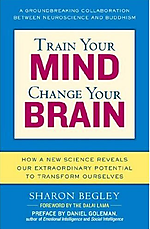Train Your Mind, Change Your Brain by Sharon Begley

with a foreword by the Dalai Lama
Part One: An Introduction
This book is better than it’s title. Not so much a one-size-fits-all set of instructions for training your mind—in fact not that at all—but rather a systematic review, in clear plain language, of the relevant neuroscience.
By the time you come to the end of this book, you might well begin to suspect that we’re training our minds all the time—at the same time changing our brains—whether we’re aware of it or not. And you might even find yourself wanting to design your own personalized set of instructions.
That said, this is also somewhat of a dense book—there’s a lot of information here. And I’m thinking that rather than try to brush by all of it on one page I’m going to offer an introduction here—enough to give a sense of the book—and then over the next couple months I’m going to take a few of the chapters and look at them more closely.
So, an overview—courtesy of the 5 Ws.
WHAT AND WHEN?
A meeting of the Mind and Life Institute in 2004 on neuroplasticity. This meeting offering the occasion—and the structure—for Sharon Begley’s book. The history of the meeting is interesting.
Back in 1983, an entrepreneur in California, Adam Engle, who was also a practicing Buddhist, heard that the Dalai Lama was interested in science. Engle got the notion of making something happen, perhaps a meeting of some sort. Aware of Fritjof Capra’s book, The Tao of Physics, his first thought was that physics would become the science of interest. He met with Capra, and found him “lukewarm” to the idea. Not long afterward he got a call from a neuroscientist, also a practicing Buddhist, by the name of Francisco Varela who had met the Dalai Lama at a conference on consciousness. He is reported to have told Engle on the phone: “you don’t want this to be on physics; cognitive science makes much more sense.”
Thus the Mind & Life Institute was born. A bevy of cognitive scientists meeting periodically with the Dalai Lama and Buddhist scholars. This particular meeting on neuroplasticity is number XII in the series.
WHERE?
The conference was held at Upper Dharamsala, in Northern India, the Dalai Lama’s home in exile. The meeting took place in the Dalai Lama’s compound, and I appreciate that Sharon Begley gives a sense of the place: “forested with pines and rhododendrons; ceramic pots spilling purple bougainvillea and saffron marigolds surrounding the widely spaced buildings.”
WHO?
Five neuroscientists
and
The Dalai Lama
along with assorted others—including scientists, Buddhist scholars and students, philanthropists, and journalists—-(all these folks are at the meeting but few speak—mostly the book is about the work of the 5 neuroscientists as it pertains to plasticity; occasionally the Dalai Lama speaks)
WHY?
The central question of the conference: Does the brain have the ability to change, and what is the power of the mind to change it?
WHAT DO I WISH THIS BOOK WOULD HAVE DONE?
(An extra W)
I wish the book would have offered more of a sense of dialogue among the scientists and the Dalai Lama along with the Buddhist scholars and students who were also present. Much of the book is presented as summaries of research. When the Dalai Lama’s words are included they’re a bit terse. Perhaps he was terse at the meeting itself—more of a listener—a presence. Or perhaps Begley felt she had to do it this way in the interests of clarity. Still, I wish there had been more of a sense of dialogue. That said, it’s a book worth reading. And perhaps one result of this lack can be a shift of more responsibility to the reader—an opportunity here for a reader to create a dialogue with the material.
For me, the question I find myself asking over and over again as I read is what might be some of the implications of this? How might this model of neuroplasticity inform what’s possible? What kinds of things does the model point toward?
_____________________________________________________
Of interest:
This book is currently ranked # 914 in books on Amazon—which speaks, it seems, to an enormous and perhaps surprising level of interest in this plasticity and our capacity for change
See also:
The Mind & Life Institute
Finally, if you like audio podcasts (free audio in mp3 format) and if you are interested in coming at the meeting of Buddhism and cognitive science from the other side–the Buddhist side–you may be interested in a podcast I recently discovered by a Buddhist teacher, Robina Courtin. The teaching is entitled The Importance of Bodhicitta and can be found here, along with several of her other teachings. It can also be found in the iTunes store–also free. I put the teaching on my iPod the other day and found her a good walking companion. Nice images, including one in which she describes the mind as a workshop.

